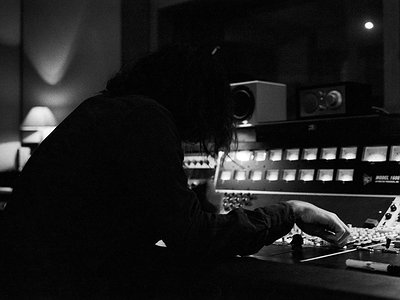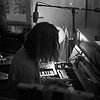Name: Jan Wagner
Nationality: German
Occupation: Producer, Sound Artist
Current Release: Nummern on Klangbad
Recommendations: First thing is a painting by Anselm Kiefer. It is “The Renowned Orders of the Night”. The painting is exhibited at Guggenheim Museum Bilbao. It is one of those pictures you can’t describe, you have to stand in front of it and look at it.
Second thing is the new album by Laura Marling and Mike Lindsay called “LUMP”. Also indescribable, take your time and listen to this piece of music.
If you enjoyed this interview with Jan Wagner, visit his Facebook account for more information and current news.
When did you start writing/producing music - and what or who were your early passions and influences? What what is about music and/or sound that drew you to it?
I started playing the piano at the age of five. My father runs a music school on the ground floor of our house. In the evenings I would sneak downstairs to play the piano.
Since my older brother listened to rap music a lot, those were my first memorable musical influences. Not long after that my friends and I started making our own beats and playing with samples down in my father’s music school, where we built our very first little studio. I am that one guy that kind of never left this studio situation since (laughs).
The piano always attracted me in some strange way. Playing a chord and releasing it into the surroundings until it dies away has been intriguing to me since I was a child.
My first time witnessing the recording of „Faust Is Last“ at Hans Joachim Irmler’s Faust Studio at the age of 17 totally blew my mind. Their approach to music and production was totally new to me and I instantly had a feeling of belonging as a musical artist. This was when I knew for sure what my profession was going to be.
For most artists, originality is first preceded by a phase of learning and, often, emulating others. What was this like for you? How would you describe your own development as an artist and the transition towards your own voice? What is the relationship between copying, learning and your own creativity?
Discovering new music is always hard for me since I cannot do this half-heartedly. Therefore I don’t listen to a wide range of music normally. When a piece of music speaks to me I absorb and internalise it. When I like a piece I just cannot stop listening to it. This might be the reason why I don´t know most of the Beatles songs nor did I listen to the whole Rolling Stones repertoire, or worshiped Jimi Hendrix when I was a teenager. In my opinion every piece of music should be treated with respect and in that case respect comes with thoroughness while listening to it. Consuming big amounts of music comes with the danger of devaluing the music and its maker.
In my own music I try to be as pure as possible, so it can be the most accurate image of that part of me. Early on I recognised the music I make is more melancholic than cheerful. Furthermore, the music that I listen to mostly is more melancholic than cheerful. Before I started what became the “Nummern” LP I didn´t compose any music of my own for quite a long time. I mixed and produced other artists. In my experience there is no such thing as copying other artists, to me it’s more an embodiment of certain musical styles to create your own. Copying music would be boring, wouldn’t it? (laughs)
What were your main compositional- and production-challenges in the beginning and how have they changed over time?
It was most challenging for me to reduce the process and the music itself to its core, to leave away all the bells and whistles and concentrate on my inner self. When I first started producing music I tended to overload my productions. I always thought they weren’t loud or loaded enough. I built a musical wall out of many different pieces to be able to hide behind it. It was not until much later that I realised that I had to strip down and just listen to my inner voice. When there are so many options it’s most difficult to go with just one chord for example.
What was your first studio like? How and for what reasons has your set-up evolved over the years and what are currently some of the most important pieces of gear for you?
My first “studio” was a pimped out Windows XP with Cubase 2.2 (laughs). At that time with just a two-channel sound-card. Back then I never really understood MIDI so I played everything a hundred times until I got what I wanted. Now I’m facing an API console and endless capacity of tracks. For the album I mostly used a pair of Neumann KM84 and set them up in front of me pointing to my fingers and just recorded in stereo. In this process the limitation helped me to concentrate on what’s essential. Using just two microphones kept me from losing myself in technical details. The more microphones or channels I use, the more I have to decide for and against different things. These decisions take so much energy and I’d rather use that for playing. At the moment I work a lot with the KM84s and a pair of U67 with BAE 1073 Preamps. That’s mostly it.
How do you make use of technology? In terms of the feedback mechanism between technology and creativity, what do humans excel at, what do machines excel at?
I use technology to build layers. I’m a huge fan of new technologies even though I don’t always use them myself. Ableton is a massive revolution for the music world. Having Protools next to you and being able to record everything everywhere is simply fantastic. You can record layer after layer all day and still work on them while sitting in the train on your way home. This is what machines excel at. The process of making music never ends. But with all these possibilities you still need an idea. And this is what humans excel at. In the end the first idea for a new piece of music comes from yourself. It’s the human intuition and desire to express itself in a creative way, not the machine’s. And if machines can help us with that, why not use them.
Production tools, from instruments to complex software environments, contribute to the compositional process. How does this manifest itself in your work? Can you describe the co-authorship between yourself and your tools?
It makes the whole process a lot easier. I mostly improvise and record that. After the first sketches I layer some new ideas on top of that. So the DAW is the heart of the studio. But I wouldn´t call it a co-authorship between myself and the DAW because it still comes out of your hand and not the computer’s. It’s more a servant who’s always at my disposal.



